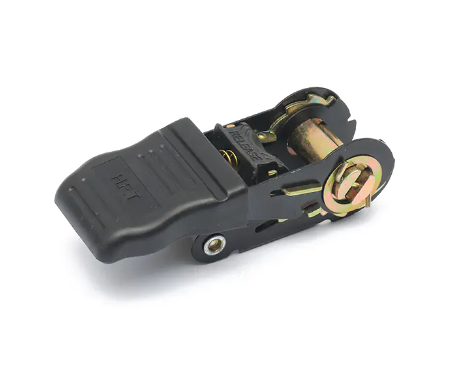No.2 new District Minglun Village,Wuxiang Town,Yinzhou District
-

Tel: +86 18658447778
-

E-mail: [email protected]
-


Content
Common errors
Foreign objects (sand, plastic chips) stuck between the ratchet teeth
Wear and deformation of the lock tongue (caused by long-term overload)
Failure of the spring sheet (unable to rebound and tighten)
Solution
Cleaning the ratchet teeth: Use a toothbrush + alcohol to clean the tooth groove (pay special attention to the hidden area at the bottom).
Visually inspect the lock tongue: If wear is found (as shown in the figure), the entire ratchet head needs to be replaced.
Judgment standard: The lock tongue bevel is ground flat>1mm and is scrapped.
Test the spring sheet: Press the lock tongue manually, it should rebound automatically and the force is uniform.
Common errors
The pulling direction is not parallel to the ratchet groove (generating lateral force)
The upward angle of 15°~30° is not maintained when the belt is retracted
Correct operation
When tightening: Make sure that the webbing is fully embedded in the groove without twisting or folding.
Retraction angle: Keep "low in and high out" to prevent the webbing from slipping.
Data support: When the angle deviation is greater than 45°, the locking force decreases by 60%.
Common mistakes
Use non-standard webbing (thickness/hardness does not match)
The burrs at the ends of the webbing are inserted into the mechanism
Matching Standard
|
Ratchet Type |
Applicable Webbing Thickness |
Maximum Width |
|
Small (25mm) |
1.2~1.5mm |
25mm |
|
Medium (50mm) |
1.8~2.2mm |
50mm |
|
Heavy (75mm) |
2.5~3.0mm |
75mm |
Note: If the edge of the webbing is fuzzy, it needs to be trimmed with a hot cutter before installation.
Applicable scenarios: ordinary outdoor environment (non-coastal, non-chemical).
Process characteristics: electroplated zinc layer (8~12μm) on carbon steel surface, and then chromate passivation to enhance corrosion resistance.
Protective effect: no red rust in neutral salt spray test for 96 hours, the lowest cost.
Disadvantages: zinc layer is easy to rust after wear, and sand and stone friction should be avoided.
Applicable scenarios: high humidity, weak acid environment (such as logistics vehicles, storage equipment).
Process characteristics: zinc aluminum sheet and chromate composite coating, baked and cured at 300℃.
Protective effect: no red rust in salt spray test for 500 hours, no risk of hydrogen embrittlement, suitable for high-strength parts.
Maintenance suggestions: check the coating damage every 2 years and reapply.
Applicable scenarios: harsh environments such as marine transportation and port machinery.
Process characteristics: 460℃ molten zinc bath immersion plating to form an 80~120μm zinc-iron alloy layer.
Protective effect: no red rust after 2000 hours of salt spray test, strong resistance to mechanical wear.
Disadvantages: weight increased by 15%, not suitable for precision ratchet structure.
Applicable scenarios: strong acid and strong alkali environment (such as chemical plants, electroplating workshops).
Process characteristics: electrostatic spraying of 150~200μm epoxy powder, curing at 200℃.
Protective effect: resistant to 10% sulfuric acid spray for 30 days without corrosion, excellent insulation.
Upgrade plan: use fluorine-modified epoxy resin, weather resistance increased by 50%.
Applicable scenarios: extreme environment (offshore platforms, polar equipment).
Process characteristics: vacuum ion plating titanium aluminum nitrogen (TiAlN) coating, hardness up to HV2000.
Protection effect: No corrosion after 5000 hours of salt spray test, high temperature resistance up to 800℃.
Disadvantages: High cost, unit price is 3~5 times that of ordinary galvanizing.
Regular inspection: Use a magnifying glass to check if the coating is cracked every quarter.
Cleaning and maintenance:
Seawater environment: rinse with fresh water every week;
Chemical environment: wipe with alcohol every month.